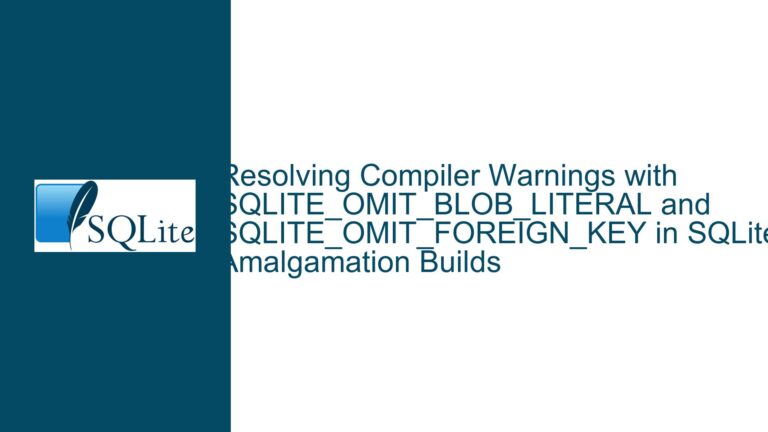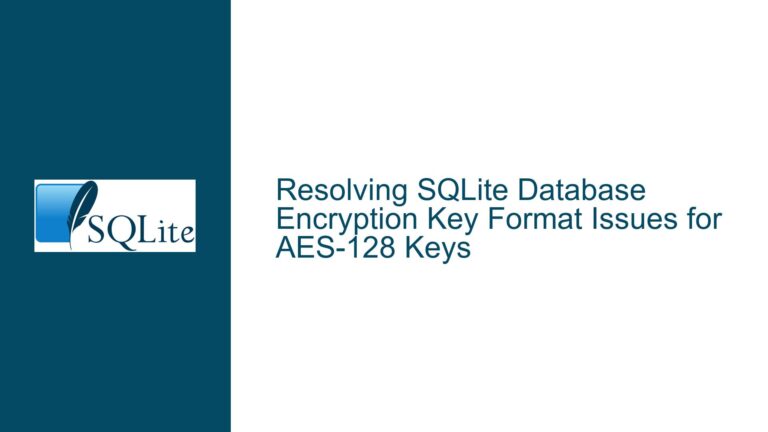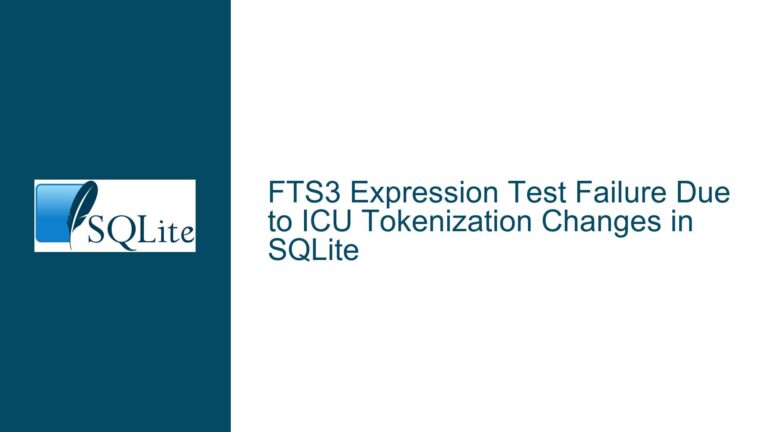Loading SQLite Database from memfd Using mmap for Read-Only Access
Understanding the Challenge of Loading SQLite from memfd via mmap
The core issue revolves around the feasibility of loading an SQLite database from a memory file descriptor (memfd) using memory mapping (mmap) for read-only, immutable access. This scenario arises in highly isolated environments where traditional file system access is restricted, and the database must be initialized from an in-memory representation. The goal is to leverage SQLite’s capabilities in such constrained environments while maintaining performance and security.
The challenge lies in SQLite’s architecture, which is designed primarily for file-based storage. SQLite databases are typically accessed through file handles, and the library relies on file system operations for tasks like reading, writing, and managing journals or write-ahead logs (WAL). However, in isolated environments, file system access is often restricted, and databases must be loaded from memory. This raises questions about how to adapt SQLite’s file-based operations to work with memory-mapped regions.
The discussion highlights several key points:
- The use of
memfd_createto create an anonymous file descriptor backed by memory. - The need to pass this file descriptor to an isolated process and initialize the database using mmap.
- The limitations of SQLite’s default behavior, which assumes file system access.
- Potential solutions involving SQLite’s serialization and deserialization APIs, custom virtual file systems (VFS), and workarounds like
/proc/<pid>/fd/<fd>.
This issue is particularly relevant for applications running in sandboxed environments, such as browser-based applications, containerized workloads, or secure microservices, where traditional file I/O is either unavailable or undesirable.
Exploring the Root Causes and Technical Constraints
The inability to load an SQLite database "just by doing a mmap" stems from several technical constraints and architectural decisions inherent to SQLite. Understanding these constraints is crucial for identifying viable solutions.
SQLite’s File-Based Architecture
SQLite is designed with a file-based architecture, meaning it expects to interact with databases as files on a file system. This design choice simplifies many aspects of database management, such as persistence, concurrency control, and crash recovery. However, it also introduces dependencies on file system operations, which become problematic in environments where file access is restricted.
When SQLite opens a database, it performs several operations:
- It reads the database header to verify the file format and determine the page size.
- It initializes internal data structures, such as the page cache and journaling mechanisms.
- It establishes locks to manage concurrent access.
These operations rely on file system APIs, making it difficult to directly use memory-mapped regions without additional steps.
The Role of mmap in SQLite
SQLite does support memory-mapped I/O (mmap) as an optimization for read-heavy workloads. When enabled, SQLite maps database pages directly into the process’s address space, reducing the overhead of system calls for reading data. However, this feature is built on top of SQLite’s file-based architecture and still requires a file descriptor to function.
The key limitation is that SQLite’s mmap support is not a standalone mechanism for loading databases. It assumes that the database is already opened using traditional file I/O and merely enhances read performance by bypassing the standard I/O routines.
Constraints in Isolated Environments
In highly isolated environments, such as sandboxed processes or containers, file system access is often restricted for security reasons. Processes may be limited to specific file descriptors or memory regions, making it impossible to use SQLite’s default file-based APIs. This restriction necessitates alternative approaches for loading databases, such as using memory-mapped regions or custom file system abstractions.
Serialization and Deserialization Overhead
One proposed solution involves using SQLite’s serialization and deserialization APIs (sqlite3_serialize and sqlite3_deserialize). These APIs allow databases to be converted to and from in-memory blobs, which can then be passed between processes or stored in memory. However, this approach introduces additional overhead:
- The database must first be serialized into a memory blob, which requires file system access.
- The deserialization process involves copying the entire database into memory, which can be inefficient for large databases.
- The deserialized database is effectively a new in-memory database, meaning it loses any connection to the original file-based storage.
These constraints highlight the need for a more direct mechanism to load databases from memory-mapped regions without relying on file system operations or serialization.
Step-by-Step Solutions and Implementation Strategies
Given the technical constraints and requirements, several strategies can be employed to load an SQLite database from a memfd using mmap for read-only access. Each approach has its trade-offs and is suited to different use cases.
Using SQLite’s Deserialization API
The most straightforward solution involves using SQLite’s sqlite3_deserialize API to load a database from a memory blob. This approach requires the following steps:
- Serialize the Database: Use
sqlite3_serializeto convert the database file into a memory blob. This step must be performed in an environment with file system access. - Create a memfd: Use
memfd_createto create an anonymous file descriptor backed by memory. - Write the Blob to memfd: Copy the serialized database blob into the memfd.
- Pass the memfd to the Isolated Process: Use inter-process communication (IPC) mechanisms to pass the memfd to the isolated process.
- Deserialize the Database: In the isolated process, use
sqlite3_deserializeto load the database from the memory blob.
This approach is relatively simple to implement but has several limitations:
- It requires file system access for the serialization step.
- The entire database must fit into memory, which may not be feasible for large databases.
- The deserialized database is effectively a new in-memory database, meaning it cannot be synchronized with the original file-based storage.
Leveraging /proc/<pid>/fd/<fd> for File Descriptor Access
Another approach involves using the /proc filesystem to access the memfd file descriptor in the isolated process. This method works as follows:
- Create a memfd: Use
memfd_createto create an anonymous file descriptor backed by memory. - Write the Database to memfd: Copy the database file into the memfd.
- Pass the memfd to the Isolated Process: Use IPC mechanisms to pass the memfd to the isolated process.
- Open the Database via
/proc/<pid>/fd/<fd>: In the isolated process, usesqlite3_open_v2with theSQLITE_OPEN_READONLYflag to open the database using the file descriptor path in/proc.
This approach avoids the need for serialization and allows the database to be accessed directly from the memfd. However, it has its own limitations:
- The
/procfilesystem must be accessible in the isolated environment. - Journaling and WAL modes may not work correctly, as they rely on creating additional files in the same directory as the database.
Implementing a Custom Virtual File System (VFS)
The most flexible and powerful solution involves implementing a custom VFS for SQLite. A custom VFS allows SQLite to interact with memory-mapped regions as if they were files, bypassing the need for file system access. The steps to implement this solution are as follows:
- Define the VFS Methods: Implement the necessary methods for the custom VFS, such as
xOpen,xRead,xWrite, andxClose. These methods will interact with the memory-mapped region instead of the file system. - Register the VFS: Use
sqlite3_vfs_registerto register the custom VFS with SQLite. - Open the Database: Use
sqlite3_open_v2with the custom VFS to open the database from the memory-mapped region.
This approach provides the most control over how SQLite interacts with the database and can support advanced features like WAL mode. However, it also requires the most effort to implement and maintain.
Example Implementation of a Custom VFS
Here is a simplified example of how a custom VFS might be implemented in C:
#include <sqlite3.h>
#include <sys/mman.h>
#include <fcntl.h>
#include <unistd.h>
// Define the VFS methods
static int memfsOpen(sqlite3_vfs* vfs, const char* zName, sqlite3_file* file, int flags, int* pOutFlags) {
// Implement the open method
return SQLITE_OK;
}
static int memfsRead(sqlite3_file* file, void* pBuf, int iAmt, sqlite3_int64 iOfst) {
// Implement the read method
return SQLITE_OK;
}
// Register the VFS
int register_memfs_vfs() {
sqlite3_vfs* pVfs = sqlite3_vfs_find(NULL);
pVfs->xOpen = memfsOpen;
pVfs->xRead = memfsRead;
// Register other methods as needed
return sqlite3_vfs_register(pVfs, 1);
}
int main() {
// Register the custom VFS
register_memfs_vfs();
// Open the database using the custom VFS
sqlite3* db;
sqlite3_open_v2("file:/memfs/db", &db, SQLITE_OPEN_READONLY, "memfs");
// Use the database
// ...
// Close the database
sqlite3_close(db);
return 0;
}
This example demonstrates the basic structure of a custom VFS. The actual implementation would need to handle additional methods and edge cases, such as error handling and memory management.
Conclusion
Loading an SQLite database from a memfd using mmap for read-only access is a complex but solvable problem. The choice of solution depends on the specific requirements and constraints of the environment. For simple use cases, the deserialization API or /proc/<pid>/fd/<fd> approach may suffice. For more advanced scenarios, a custom VFS provides the flexibility and control needed to fully leverage SQLite’s capabilities in isolated environments.
By understanding the underlying technical constraints and exploring the available solutions, developers can successfully integrate SQLite into even the most restricted environments, unlocking its full potential for lightweight, high-performance database management.






